
model2vec
Fast State-of-the-Art Static Embeddings
Stars: 1077
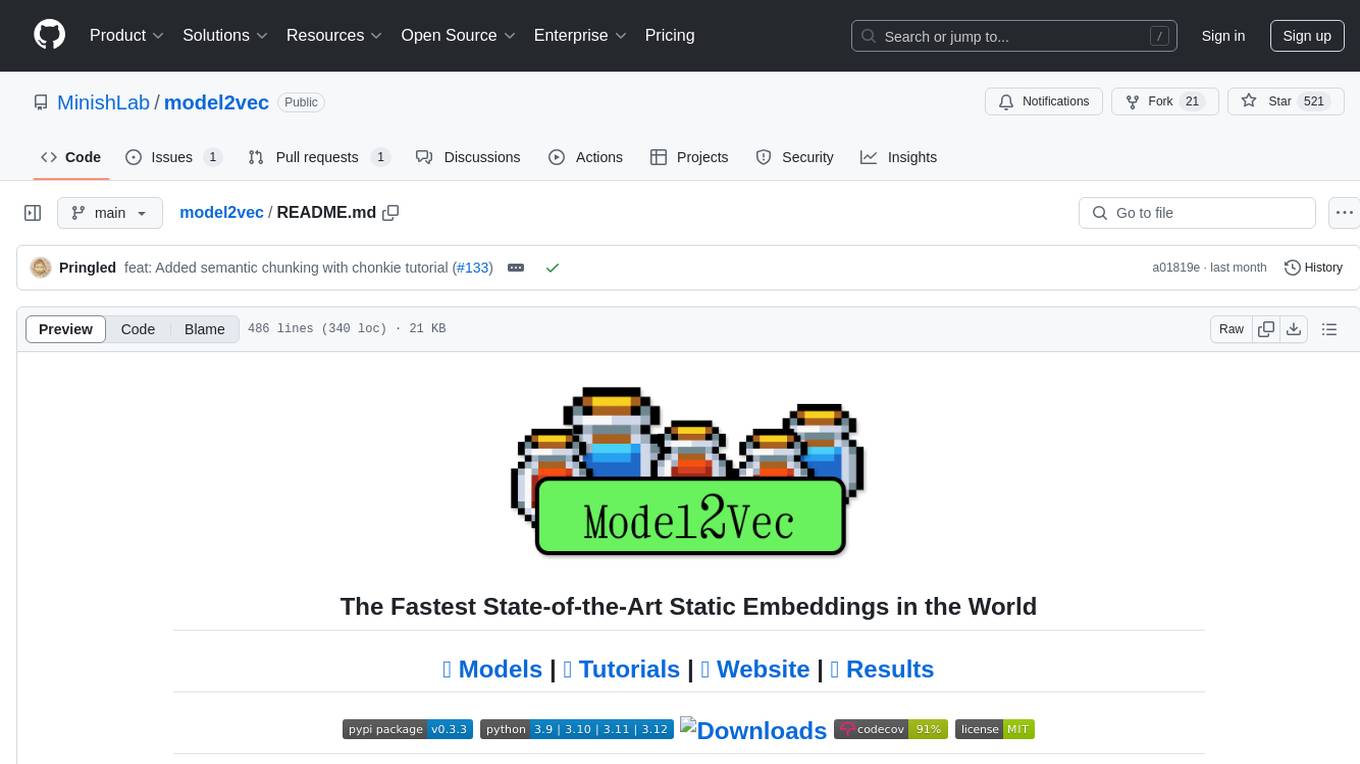
Model2Vec is a technique to turn any sentence transformer into a really small static model, reducing model size by 15x and making the models up to 500x faster, with a small drop in performance. It outperforms other static embedding models like GLoVe and BPEmb, is lightweight with only `numpy` as a major dependency, offers fast inference, dataset-free distillation, and is integrated into Sentence Transformers, txtai, and Chonkie. Model2Vec creates powerful models by passing a vocabulary through a sentence transformer model, reducing dimensionality using PCA, and weighting embeddings using zipf weighting. Users can distill their own models or use pre-trained models from the HuggingFace hub. Evaluation can be done using the provided evaluation package. Model2Vec is licensed under MIT.
README:
🤗 Models | 📚 Tutorials | 🌐 Blog | 🏆 Results | 📖 Docs
Model2Vec is a technique to turn any sentence transformer into a really small static model, reducing model size by a factor up to 50 and making the models up to 500 times faster, with a small drop in performance. Our best model is the most performant static embedding model in the world. See our results here, or dive in to see how it works.
Install the lightweight base package with:
pip install model2vecYou can start using Model2Vec by loading one of our flagship models from the HuggingFace hub. These models are pre-trained and ready to use. The following code snippet shows how to load a model and make embeddings, which you can use for any task, such as text classification, retrieval, clustering, or building a RAG system:
from model2vec import StaticModel
# Load a model from the HuggingFace hub (in this case the potion-base-8M model)
model = StaticModel.from_pretrained("minishlab/potion-base-8M")
# Make embeddings
embeddings = model.encode(["It's dangerous to go alone!", "It's a secret to everybody."])
# Make sequences of token embeddings
token_embeddings = model.encode_as_sequence(["It's dangerous to go alone!", "It's a secret to everybody."])Instead of using one of our models, you can also distill your own Model2Vec model from a Sentence Transformer model. First, install the distillation extras with:
pip install model2vec[distill]Then, you can distill a model in ~30 seconds on a CPU with the following code snippet:
from model2vec.distill import distill
# Distill a Sentence Transformer model, in this case the BAAI/bge-base-en-v1.5 model
m2v_model = distill(model_name="BAAI/bge-base-en-v1.5", pca_dims=256)
# Save the model
m2v_model.save_pretrained("m2v_model")After distillation, you can also fine-tune your own classification models on top of the distilled model, or on a pre-trained model. First, make sure you install the training extras with:
pip install model2vec[training]Then, you can fine-tune a model as follows:
import numpy as np
from datasets import load_dataset
from model2vec.train import StaticModelForClassification
# Initialize a classifier from a pre-trained model
classifier = StaticModelForClassification.from_pretrained(model_name="minishlab/potion-base-32M")
# Load a dataset. Note: both single and multi-label classification datasets are supported
ds = load_dataset("setfit/subj")
# Train the classifier on text (X) and labels (y)
classifier.fit(ds["train"]["text"], ds["train"]["label"])
# Evaluate the classifier
classification_report = classifier.evaluate(ds["test"]["text"], ds["test"]["label"])For advanced usage, please refer to our usage documentation.
-
12/02/2024: We released Model2Vec training, allowing you to fine-tune your own classification models on top of Model2Vec models. Find out more in our training documentation and results.
-
30/01/2024: We released two new models: potion-base-32M and potion-retrieval-32M. potion-base-32M is our most performant model to date, using a larger vocabulary and higher dimensions. potion-retrieval-32M is a finetune of potion-base-32M that is optimized for retrieval tasks, and is the best performing static retrieval model currently available.
-
30/10/2024: We released three new models: potion-base-8M, potion-base-4M, and potion-base-2M. These models are trained using Tokenlearn. Find out more in our blog post. NOTE: for users of any of our old English M2V models, we recommend switching to these new models as they perform better on all tasks.
- State-of-the-Art Performance: Model2Vec models outperform any other static embeddings (such as GLoVe and BPEmb) by a large margin, as can be seen in our results.
- Small: Model2Vec reduces the size of a Sentence Transformer model by a factor of up to 50. Our best model is just ~30 MB on disk, and our smallest model just ~8 MB (making it the smallest model on MTEB!).
-
Lightweight Dependencies: the base package's only major dependency is
numpy. - Lightning-fast Inference: up to 500 times faster on CPU than the original model.
- Fast, Dataset-free Distillation: distill your own model in 30 seconds on a CPU, without a dataset.
- Fine-tuning: fine-tune your own classification models on top of Model2Vec models.
- Integrated in many popular libraries: Model2Vec is integrated direclty into popular libraries such as Sentence Transformers and LangChain. For more information, see our integrations documentation.
-
Tightly integrated with HuggingFace hub: easily share and load models from the HuggingFace hub, using the familiar
from_pretrainedandpush_to_hub. Our own models can be found here.
Model2vec creates a small, fast, and powerful model that outperforms other static embedding models by a large margin on all tasks we could find, while being much faster to create than traditional static embedding models such as GloVe. Like BPEmb, it can create subword embeddings, but with much better performance. Distillation doesn't need any data, just a vocabulary and a model.
The core idea is to forward pass a vocabulary through a sentence transformer model, creating static embeddings for the indiviudal tokens. After this, there are a number of post-processing steps we do that results in our best models. For a more extensive deepdive, please refer to the following resources:
- Our initial Model2Vec blog post. Note that, while this post gives a good overview of the core idea, we've made a number of substantial improvements since then.
- Our Tokenlearn blog post. This post describes the Tokenlearn method we used to train our potion models.
- Our official documentation. This document provides a high-level overview of how Model2Vec works.
Our official documentation can be found here. This includes:
- Usage documentation: provides a technical overview of how to use Model2Vec.
- Integrations documentation: provides examples of how to use Model2Vec in various downstream libraries.
- Model2Vec technical documentation: provides a high-level overview of how Model2Vec works.
We provide a number of models that can be used out of the box. These models are available on the HuggingFace hub and can be loaded using the from_pretrained method. The models are listed below.
| Model | Language | Sentence Transformer | Params | Task |
|---|---|---|---|---|
| potion-base-32M | English | bge-base-en-v1.5 | 32.3M | General |
| potion-base-8M | English | bge-base-en-v1.5 | 7.5M | General |
| potion-base-4M | English | bge-base-en-v1.5 | 3.7M | General |
| potion-base-2M | English | bge-base-en-v1.5 | 1.8M | General |
| potion-retrieval-32M | English | bge-base-en-v1.5 | 32.3M | Retrieval |
| M2V_multilingual_output | Multilingual | LaBSE | 471M | General |
We have performed extensive experiments to evaluate the performance of Model2Vec models. The results are documented in the results folder. The results are presented in the following sections:
MIT
If you use Model2Vec in your research, please cite the following:
@software{minishlab2024model2vec,
authors = {Stephan Tulkens and Thomas van Dongen},
title = {Model2Vec: Fast State-of-the-Art Static Embeddings},
year = {2024},
url = {https://github.com/MinishLab/model2vec}
}For Tasks:
Click tags to check more tools for each tasksFor Jobs:
Alternative AI tools for model2vec
Similar Open Source Tools

model2vec
Model2Vec is a technique to turn any sentence transformer into a really small static model, reducing model size by 15x and making the models up to 500x faster, with a small drop in performance. It outperforms other static embedding models like GLoVe and BPEmb, is lightweight with only `numpy` as a major dependency, offers fast inference, dataset-free distillation, and is integrated into Sentence Transformers, txtai, and Chonkie. Model2Vec creates powerful models by passing a vocabulary through a sentence transformer model, reducing dimensionality using PCA, and weighting embeddings using zipf weighting. Users can distill their own models or use pre-trained models from the HuggingFace hub. Evaluation can be done using the provided evaluation package. Model2Vec is licensed under MIT.
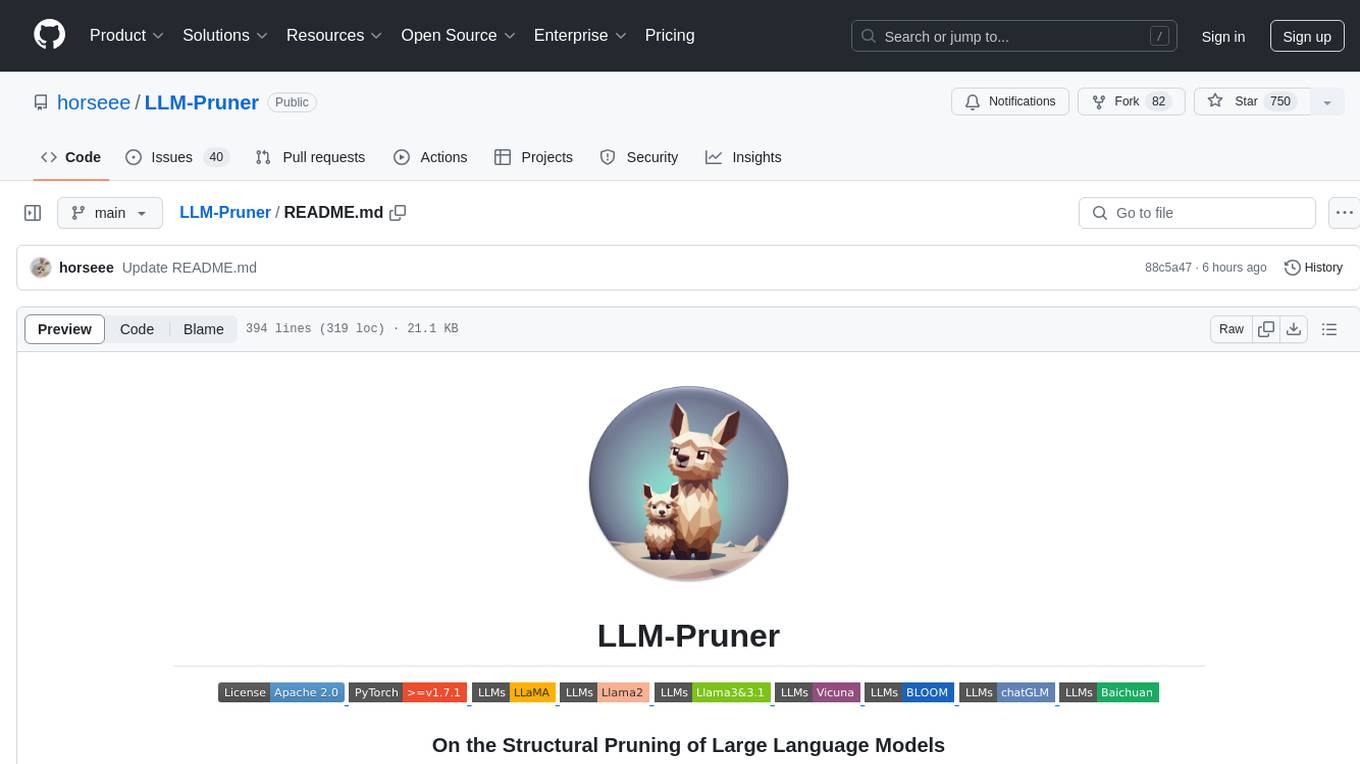
LLM-Pruner
LLM-Pruner is a tool for structural pruning of large language models, allowing task-agnostic compression while retaining multi-task solving ability. It supports automatic structural pruning of various LLMs with minimal human effort. The tool is efficient, requiring only 3 minutes for pruning and 3 hours for post-training. Supported LLMs include Llama-3.1, Llama-3, Llama-2, LLaMA, BLOOM, Vicuna, and Baichuan. Updates include support for new LLMs like GQA and BLOOM, as well as fine-tuning results achieving high accuracy. The tool provides step-by-step instructions for pruning, post-training, and evaluation, along with a Gradio interface for text generation. Limitations include issues with generating repetitive or nonsensical tokens in compressed models and manual operations for certain models.
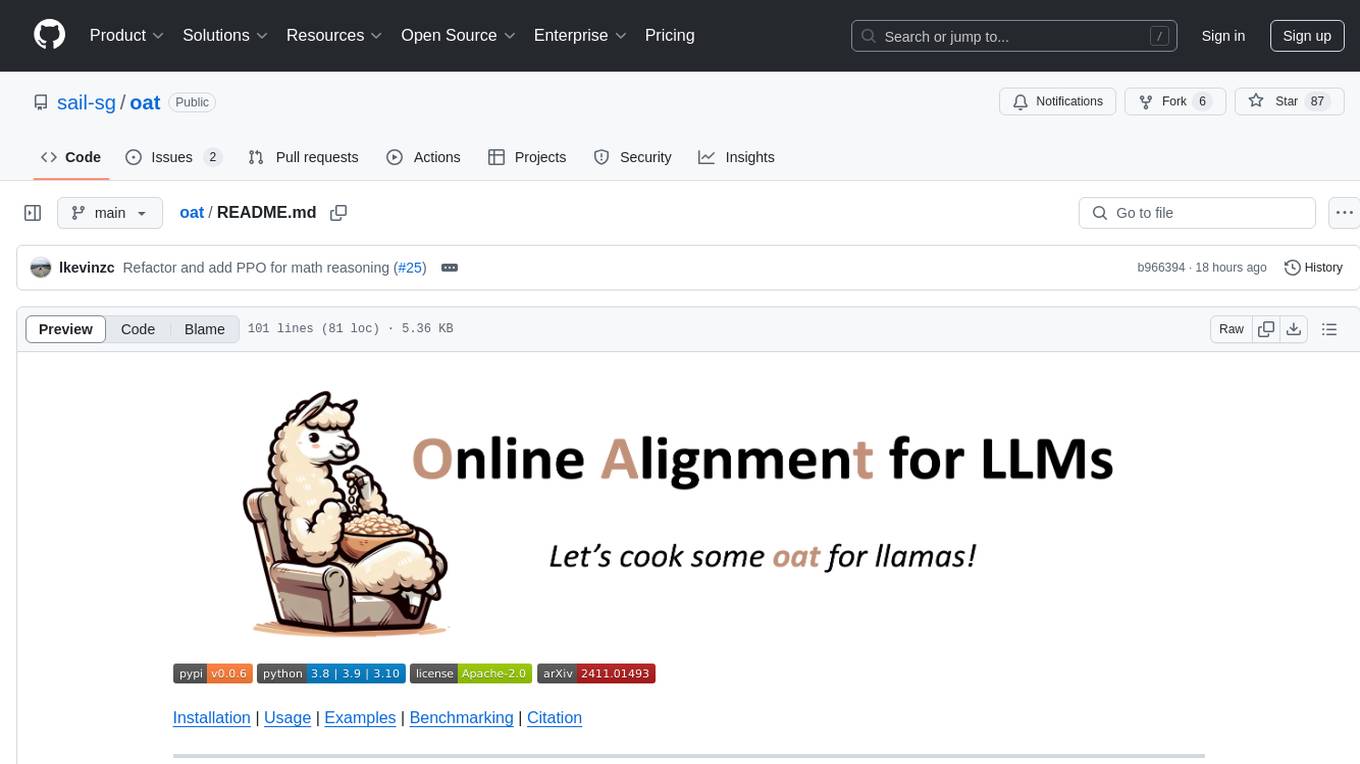
oat
Oat is a simple and efficient framework for running online LLM alignment algorithms. It implements a distributed Actor-Learner-Oracle architecture, with components optimized using state-of-the-art tools. Oat simplifies the experimental pipeline of LLM alignment by serving an Oracle online for preference data labeling and model evaluation. It provides a variety of oracles for simulating feedback and supports verifiable rewards. Oat's modular structure allows for easy inheritance and modification of classes, enabling rapid prototyping and experimentation with new algorithms. The framework implements cutting-edge online algorithms like PPO for math reasoning and various online exploration algorithms.
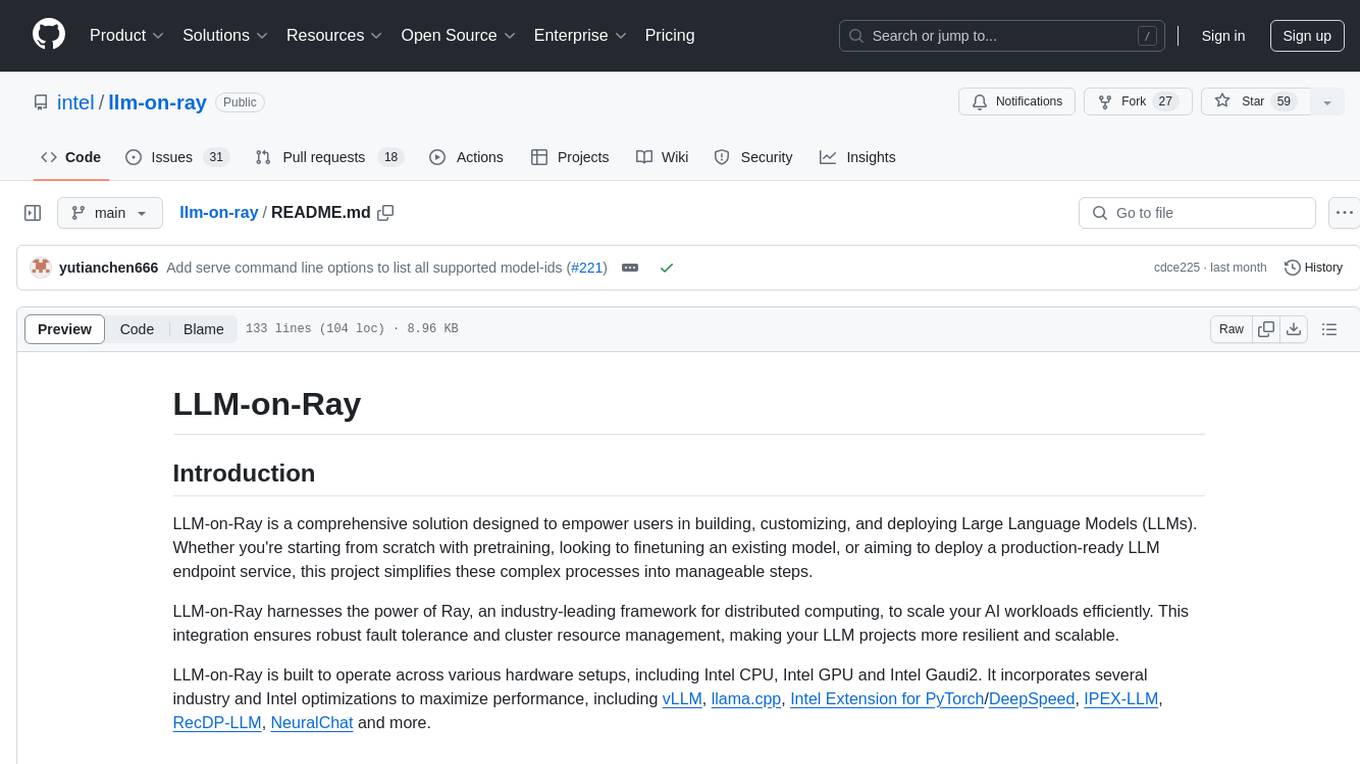
llm-on-ray
LLM-on-Ray is a comprehensive solution for building, customizing, and deploying Large Language Models (LLMs). It simplifies complex processes into manageable steps by leveraging the power of Ray for distributed computing. The tool supports pretraining, finetuning, and serving LLMs across various hardware setups, incorporating industry and Intel optimizations for performance. It offers modular workflows with intuitive configurations, robust fault tolerance, and scalability. Additionally, it provides an Interactive Web UI for enhanced usability, including a chatbot application for testing and refining models.
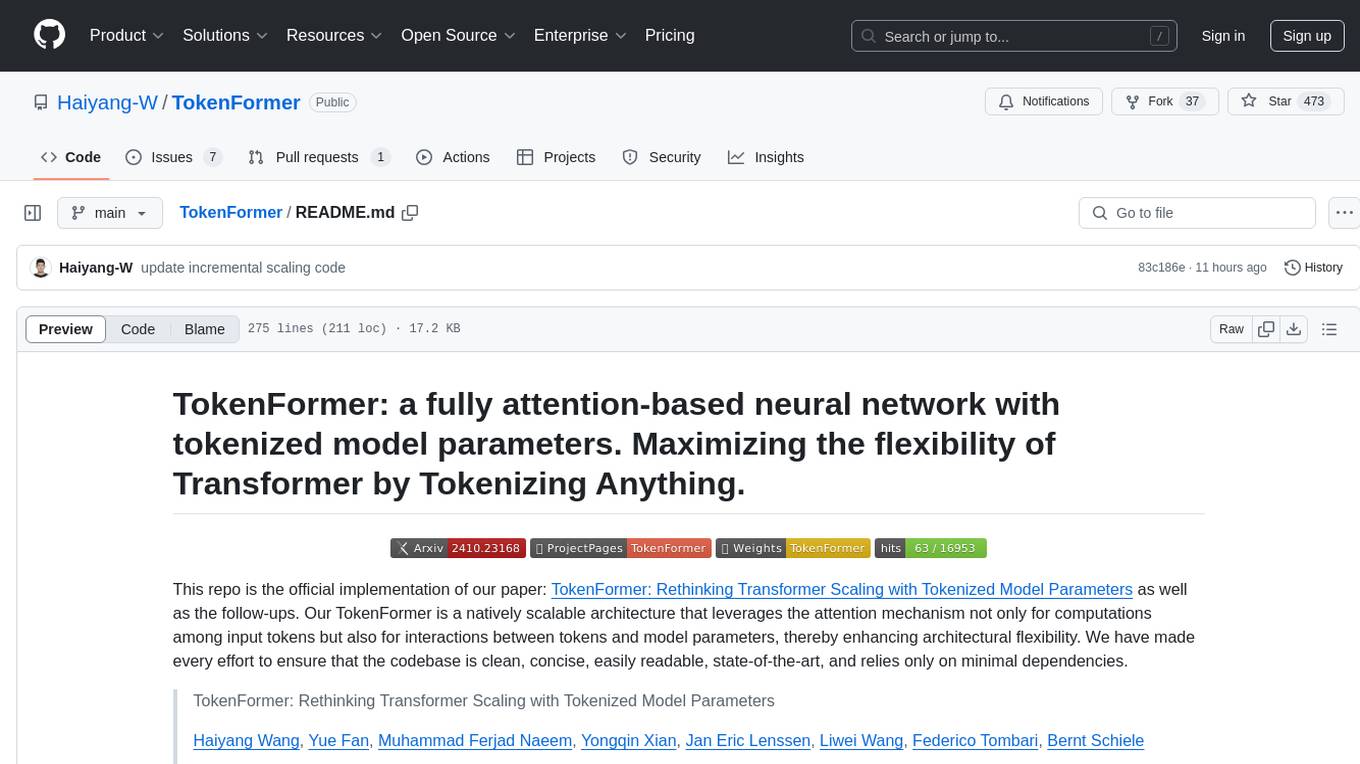
TokenFormer
TokenFormer is a fully attention-based neural network architecture that leverages tokenized model parameters to enhance architectural flexibility. It aims to maximize the flexibility of neural networks by unifying token-token and token-parameter interactions through the attention mechanism. The architecture allows for incremental model scaling and has shown promising results in language modeling and visual modeling tasks. The codebase is clean, concise, easily readable, state-of-the-art, and relies on minimal dependencies.

OpenLLM
OpenLLM is a platform that helps developers run any open-source Large Language Models (LLMs) as OpenAI-compatible API endpoints, locally and in the cloud. It supports a wide range of LLMs, provides state-of-the-art serving and inference performance, and simplifies cloud deployment via BentoML. Users can fine-tune, serve, deploy, and monitor any LLMs with ease using OpenLLM. The platform also supports various quantization techniques, serving fine-tuning layers, and multiple runtime implementations. OpenLLM seamlessly integrates with other tools like OpenAI Compatible Endpoints, LlamaIndex, LangChain, and Transformers Agents. It offers deployment options through Docker containers, BentoCloud, and provides a community for collaboration and contributions.
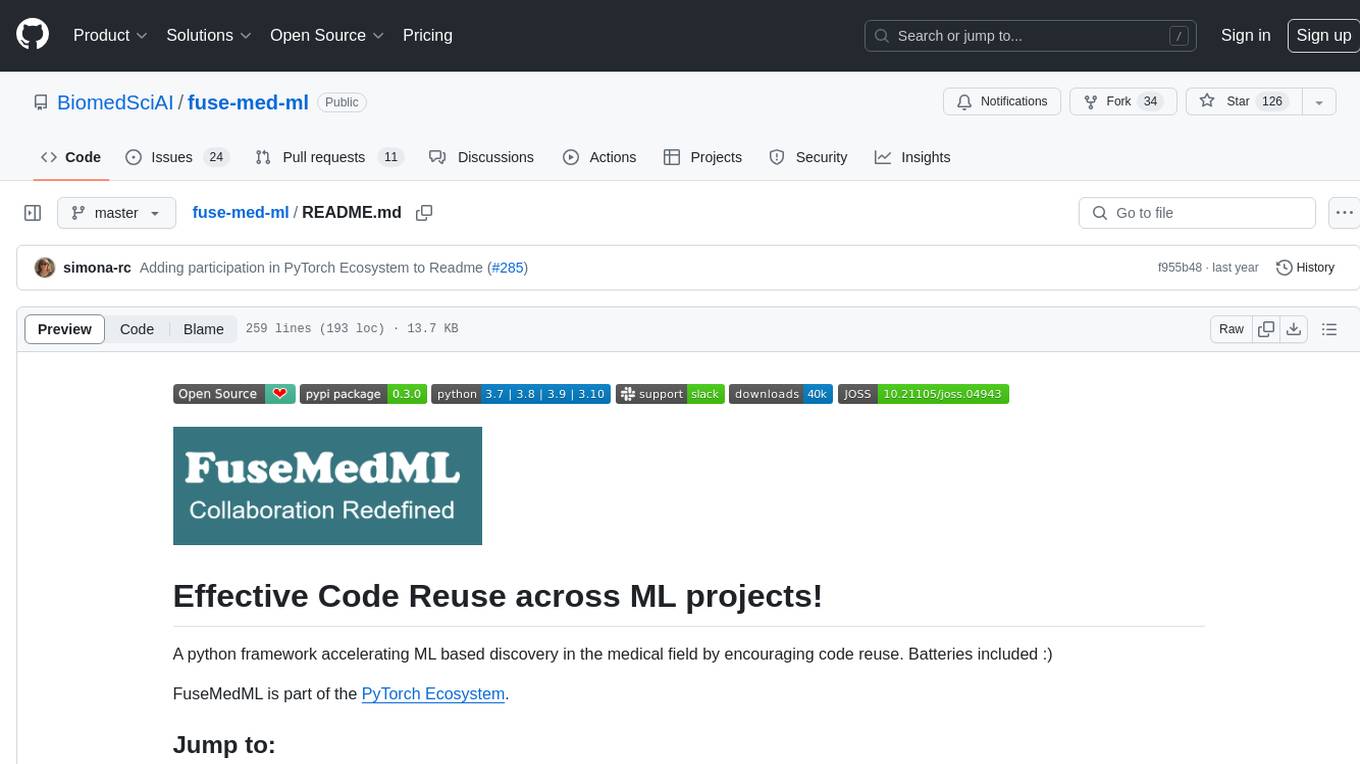
fuse-med-ml
FuseMedML is a Python framework designed to accelerate machine learning-based discovery in the medical field by promoting code reuse. It provides a flexible design concept where data is stored in a nested dictionary, allowing easy handling of multi-modality information. The framework includes components for creating custom models, loss functions, metrics, and data processing operators. Additionally, FuseMedML offers 'batteries included' key components such as fuse.data for data processing, fuse.eval for model evaluation, and fuse.dl for reusable deep learning components. It supports PyTorch and PyTorch Lightning libraries and encourages the creation of domain extensions for specific medical domains.
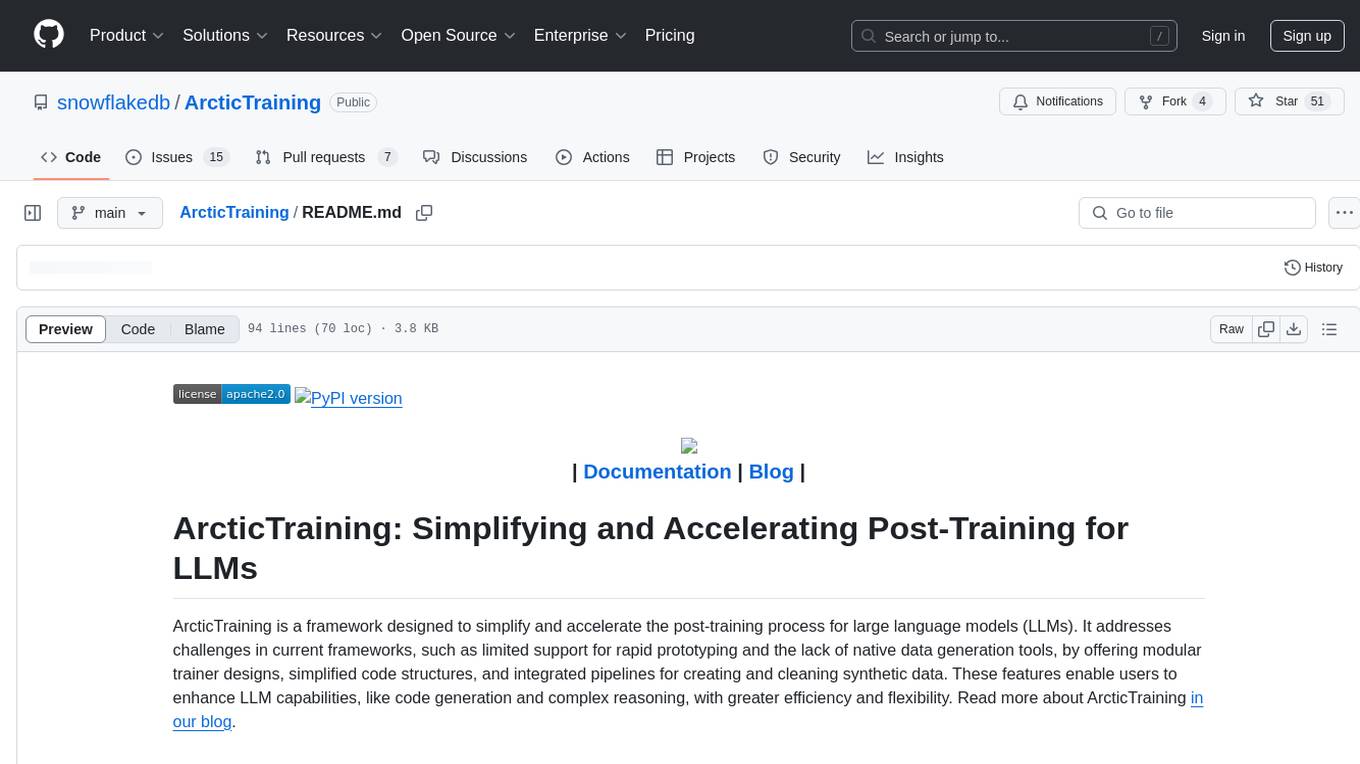
ArcticTraining
ArcticTraining is a framework designed to simplify and accelerate the post-training process for large language models (LLMs). It offers modular trainer designs, simplified code structures, and integrated pipelines for creating and cleaning synthetic data, enabling users to enhance LLM capabilities like code generation and complex reasoning with greater efficiency and flexibility.

atropos
Atropos is a robust and scalable framework for Reinforcement Learning Environments with Large Language Models (LLMs). It provides a flexible platform to accelerate LLM-based RL research across diverse interactive settings. Atropos supports multi-turn and asynchronous RL interactions, integrates with various inference APIs, offers a standardized training interface for experimenting with different RL algorithms, and allows for easy scalability by launching more environment instances. The framework manages diverse environment types concurrently for heterogeneous, multi-modal training.
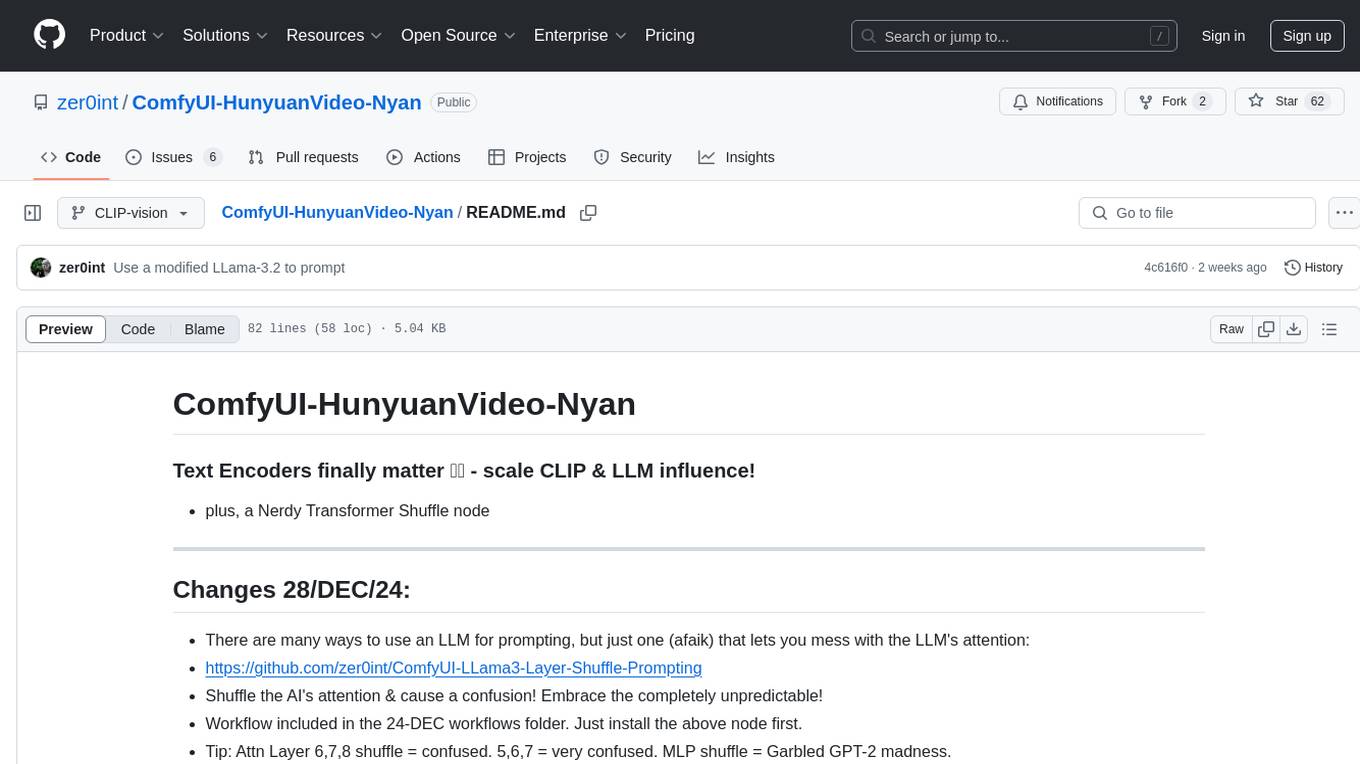
ComfyUI-HunyuanVideo-Nyan
ComfyUI-HunyuanVideo-Nyan is a repository that provides tools for manipulating the attention of LLM models, allowing users to shuffle the AI's attention and cause confusion. The repository includes a Nerdy Transformer Shuffle node that enables users to mess with the LLM's attention layers, providing a workflow for installation and usage. It also offers a new SAE-informed Long-CLIP model with high accuracy, along with recommendations for CLIP models. Users can find detailed instructions on how to use the provided nodes to scale CLIP & LLM factors and create high-quality nature videos. The repository emphasizes compatibility with other related tools and provides insights into the functionality of the included nodes.
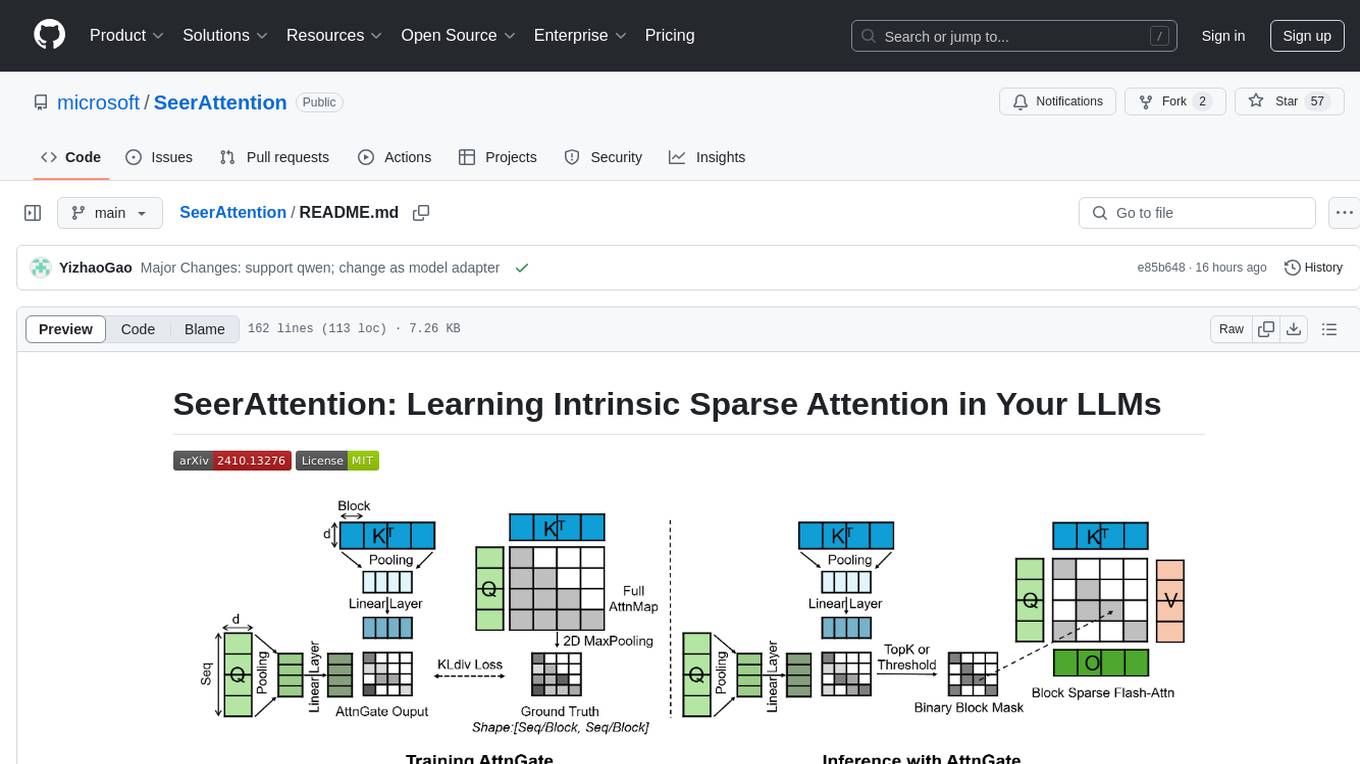
SeerAttention
SeerAttention is a novel trainable sparse attention mechanism that learns intrinsic sparsity patterns directly from LLMs through self-distillation at post-training time. It achieves faster inference while maintaining accuracy for long-context prefilling. The tool offers features such as trainable sparse attention, block-level sparsity, self-distillation, efficient kernel, and easy integration with existing transformer architectures. Users can quickly start using SeerAttention for inference with AttnGate Adapter and training attention gates with self-distillation. The tool provides efficient evaluation methods and encourages contributions from the community.
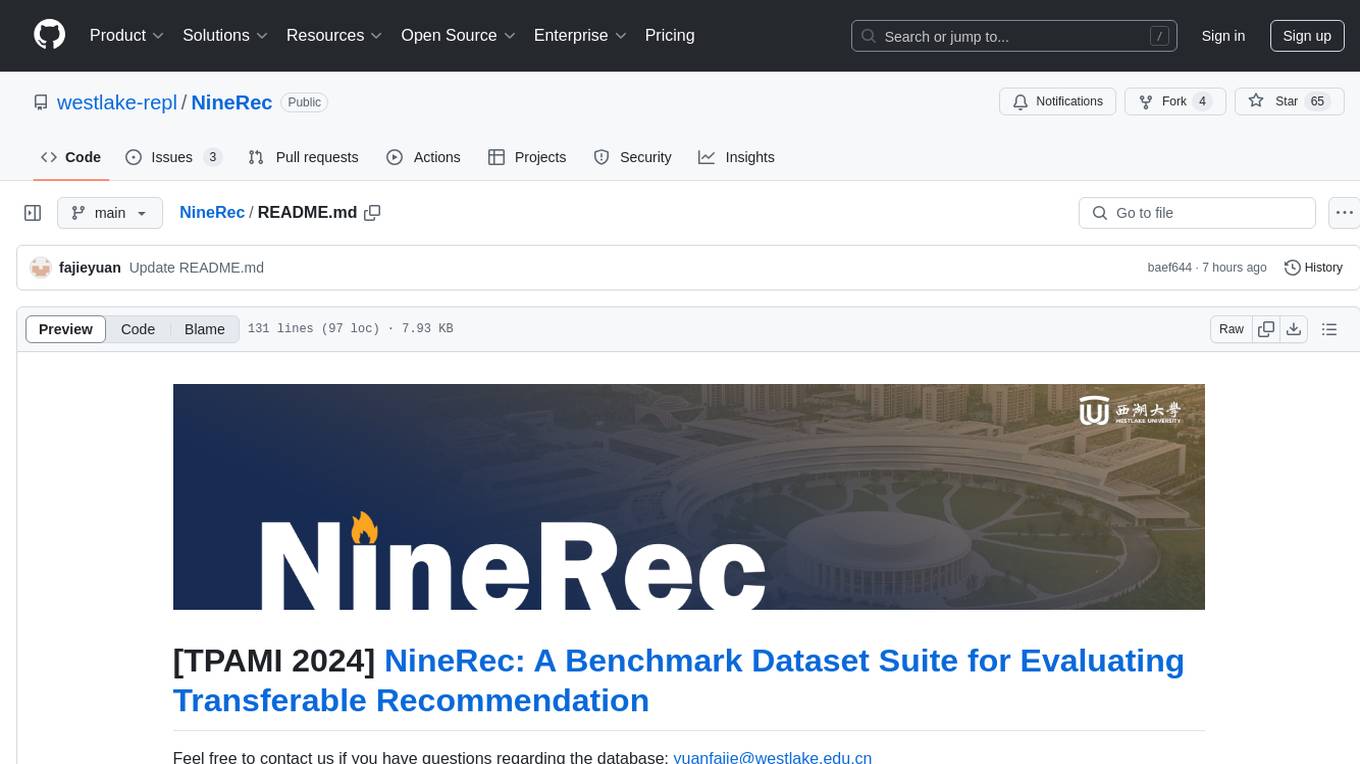
NineRec
NineRec is a benchmark dataset suite for evaluating transferable recommendation models. It provides datasets for pre-training and transfer learning in recommender systems, focusing on multimodal and foundation model tasks. The dataset includes user-item interactions, item texts in multiple languages, item URLs, and raw images. Researchers can use NineRec to develop more effective and efficient methods for pre-training recommendation models beyond end-to-end training. The dataset is accompanied by code for dataset preparation, training, and testing in PyTorch environment.

MInference
MInference is a tool designed to accelerate pre-filling for long-context Language Models (LLMs) by leveraging dynamic sparse attention. It achieves up to a 10x speedup for pre-filling on an A100 while maintaining accuracy. The tool supports various decoding LLMs, including LLaMA-style models and Phi models, and provides custom kernels for attention computation. MInference is useful for researchers and developers working with large-scale language models who aim to improve efficiency without compromising accuracy.
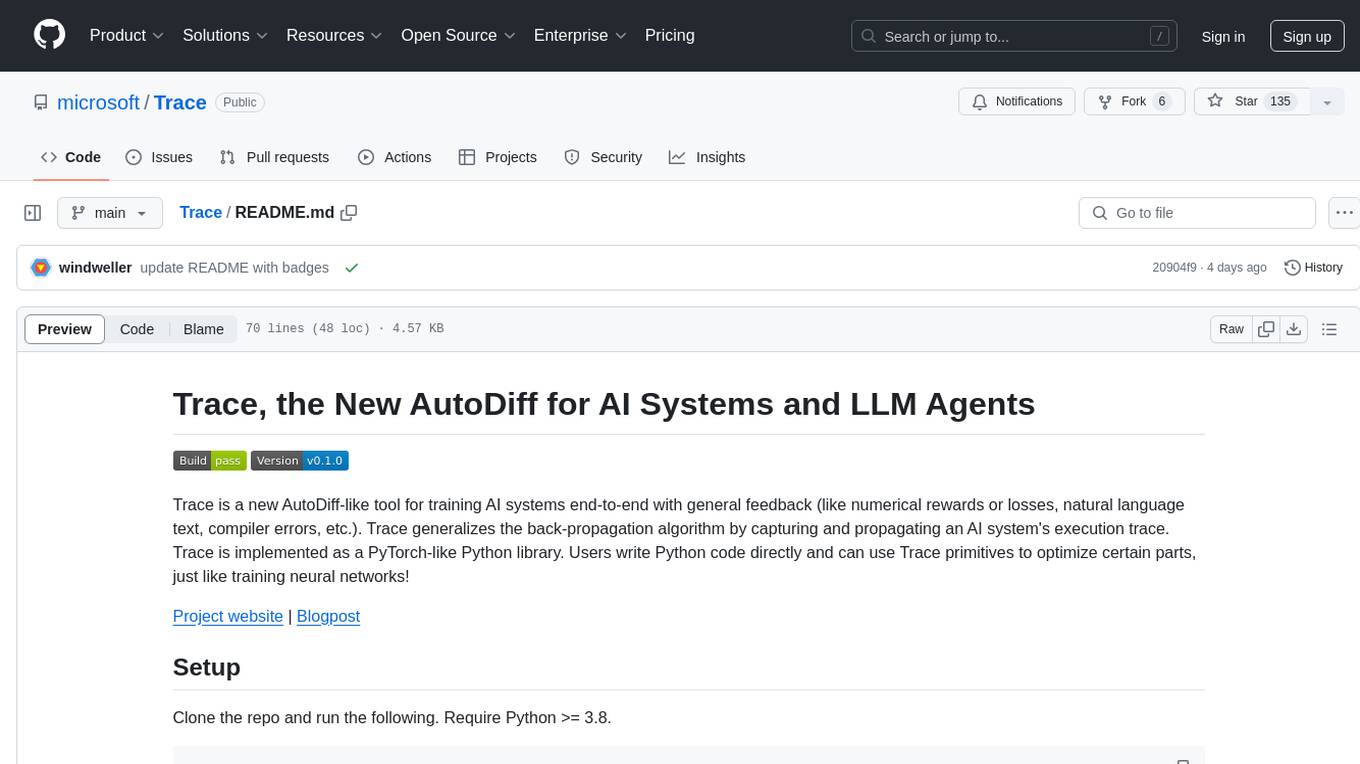
Trace
Trace is a new AutoDiff-like tool for training AI systems end-to-end with general feedback. It generalizes the back-propagation algorithm by capturing and propagating an AI system's execution trace. Implemented as a PyTorch-like Python library, users can write Python code directly and use Trace primitives to optimize certain parts, similar to training neural networks.
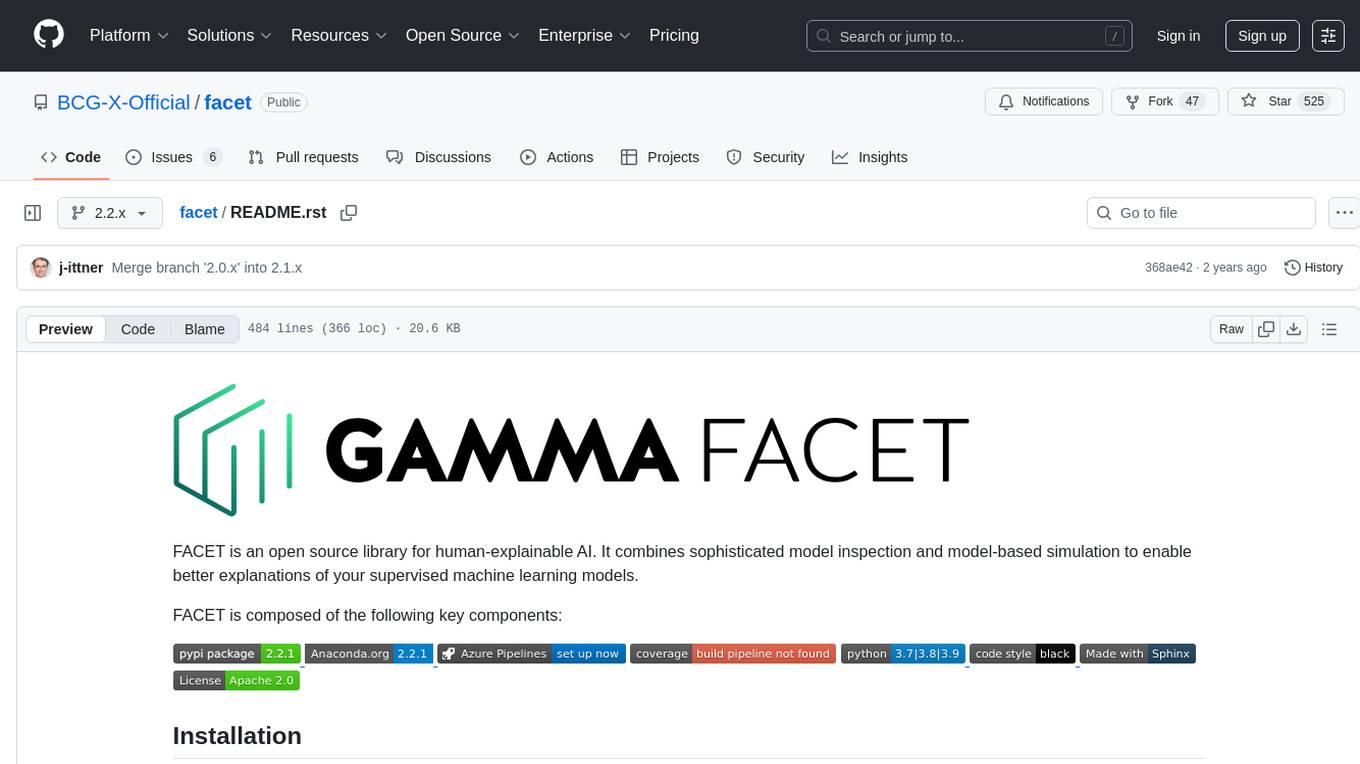
facet
FACET is an open source library for human-explainable AI that combines model inspection and model-based simulation to provide better explanations for supervised machine learning models. It offers an efficient and transparent machine learning workflow, enhancing scikit-learn's pipelining paradigm with new capabilities for model selection, inspection, and simulation. FACET introduces new algorithms for quantifying dependencies and interactions between features in ML models, as well as for conducting virtual experiments to optimize predicted outcomes. The tool ensures end-to-end traceability of features using an augmented version of scikit-learn with enhanced support for pandas data frames. FACET also provides model inspection methods for scikit-learn estimators, enhancing global metrics like synergy and redundancy to complement the local perspective of SHAP. Additionally, FACET offers model simulation capabilities for conducting univariate uplift simulations based on important features like BMI.
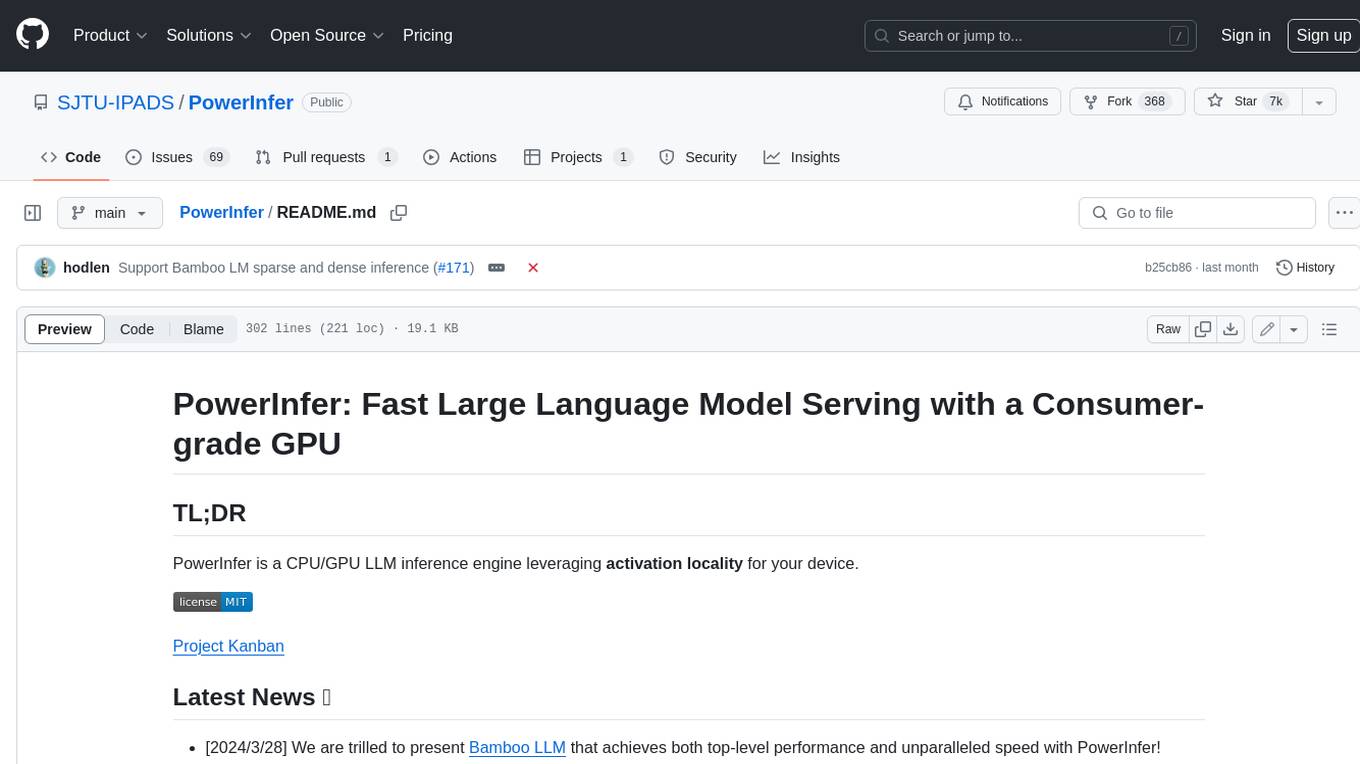
PowerInfer
PowerInfer is a high-speed Large Language Model (LLM) inference engine designed for local deployment on consumer-grade hardware, leveraging activation locality to optimize efficiency. It features a locality-centric design, hybrid CPU/GPU utilization, easy integration with popular ReLU-sparse models, and support for various platforms. PowerInfer achieves high speed with lower resource demands and is flexible for easy deployment and compatibility with existing models like Falcon-40B, Llama2 family, ProSparse Llama2 family, and Bamboo-7B.
For similar tasks
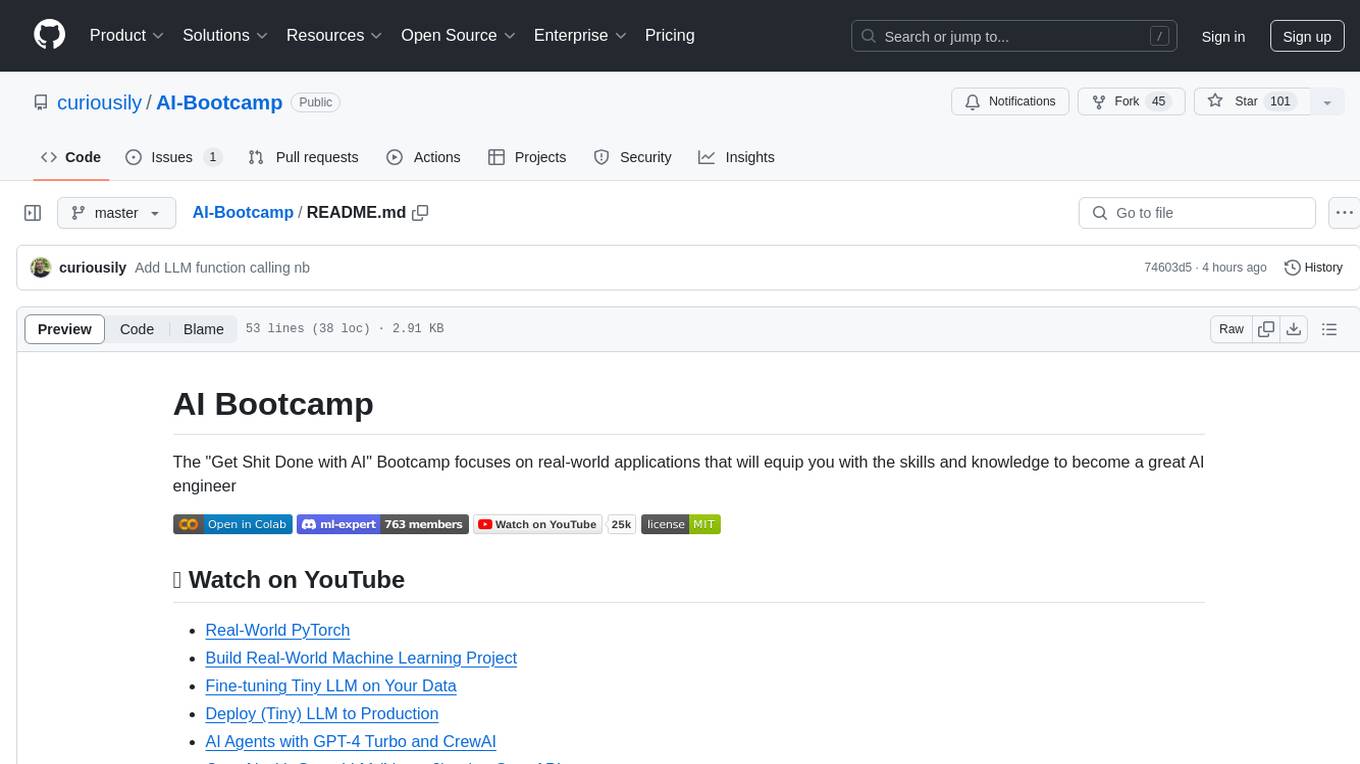
AI-Bootcamp
The AI Bootcamp is a comprehensive training program focusing on real-world applications to equip individuals with the skills and knowledge needed to excel as AI engineers. The bootcamp covers topics such as Real-World PyTorch, Machine Learning Projects, Fine-tuning Tiny LLM, Deployment of LLM to Production, AI Agents with GPT-4 Turbo, CrewAI, Llama 3, and more. Participants will learn foundational skills in Python for AI, ML Pipelines, Large Language Models (LLMs), AI Agents, and work on projects like RagBase for private document chat.

model2vec
Model2Vec is a technique to turn any sentence transformer into a really small static model, reducing model size by 15x and making the models up to 500x faster, with a small drop in performance. It outperforms other static embedding models like GLoVe and BPEmb, is lightweight with only `numpy` as a major dependency, offers fast inference, dataset-free distillation, and is integrated into Sentence Transformers, txtai, and Chonkie. Model2Vec creates powerful models by passing a vocabulary through a sentence transformer model, reducing dimensionality using PCA, and weighting embeddings using zipf weighting. Users can distill their own models or use pre-trained models from the HuggingFace hub. Evaluation can be done using the provided evaluation package. Model2Vec is licensed under MIT.
For similar jobs
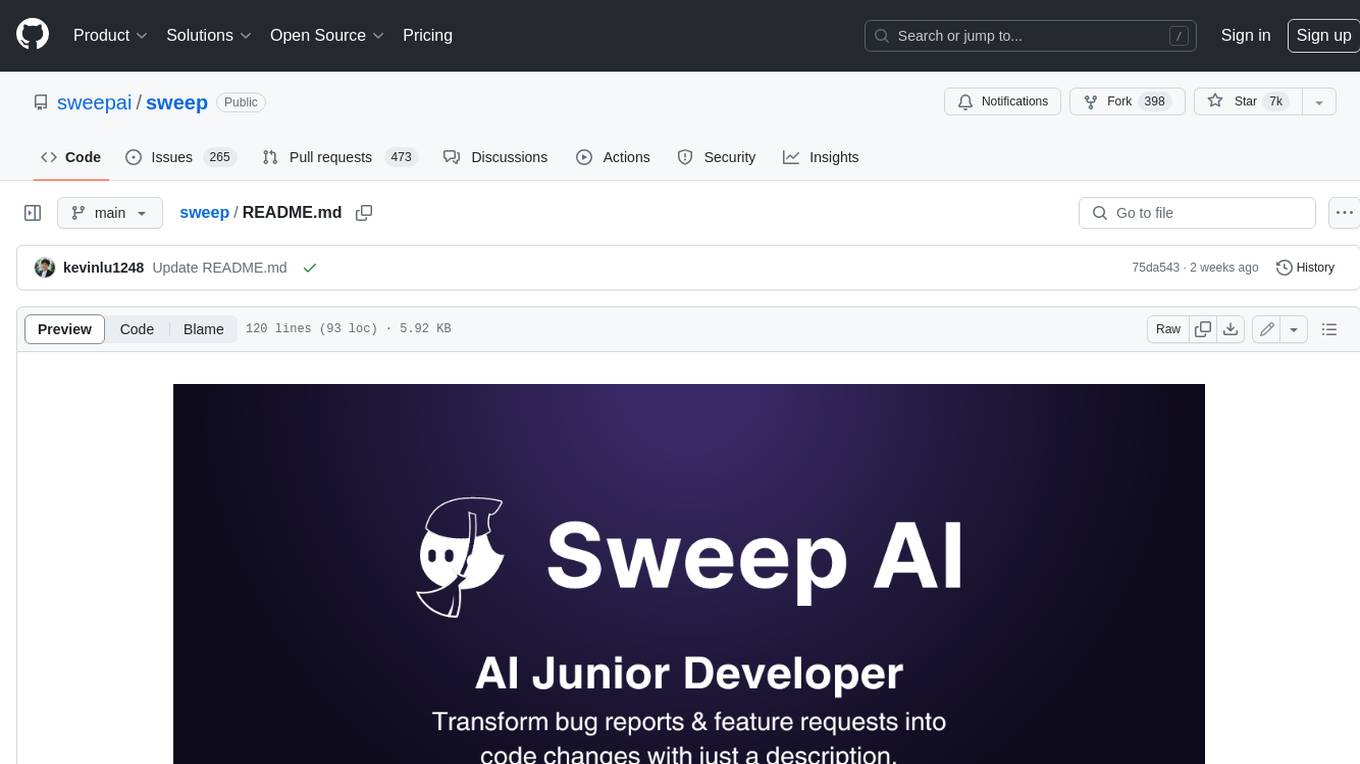
sweep
Sweep is an AI junior developer that turns bugs and feature requests into code changes. It automatically handles developer experience improvements like adding type hints and improving test coverage.
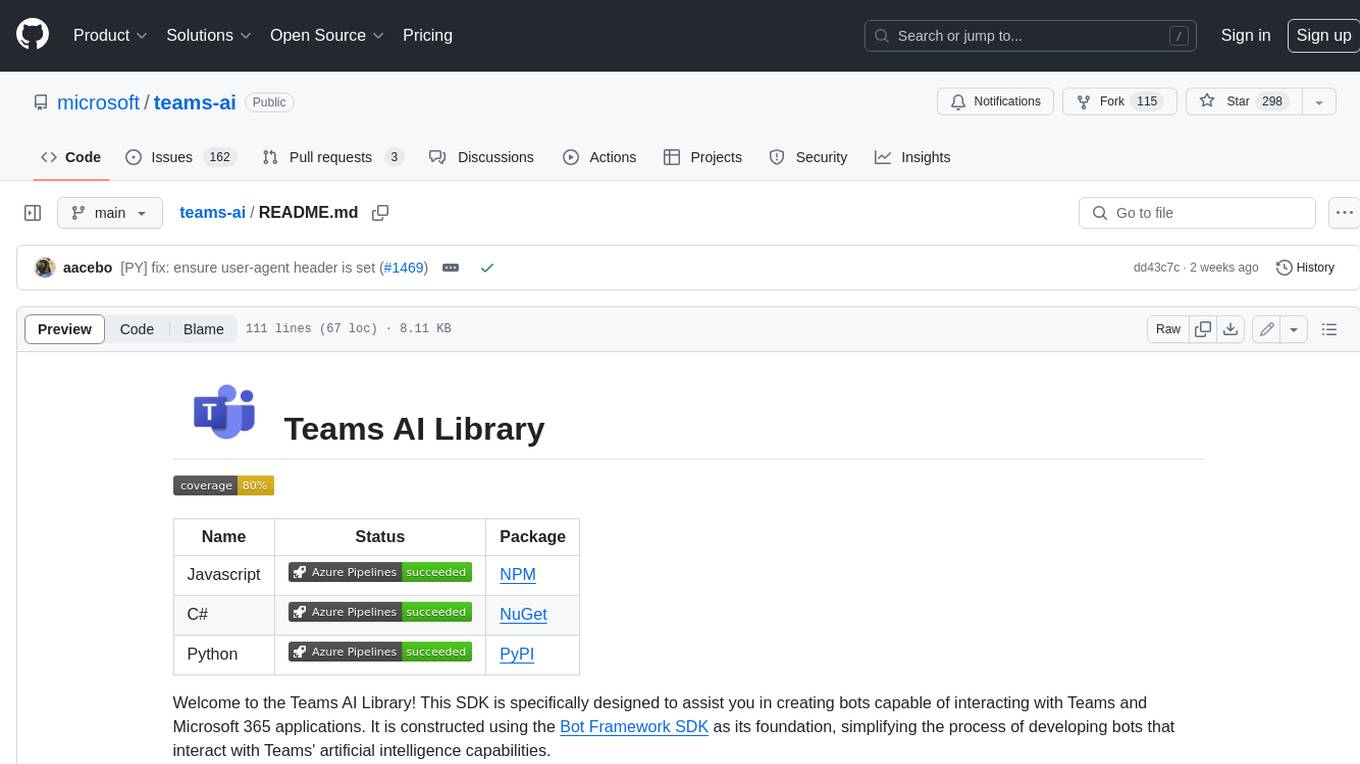
teams-ai
The Teams AI Library is a software development kit (SDK) that helps developers create bots that can interact with Teams and Microsoft 365 applications. It is built on top of the Bot Framework SDK and simplifies the process of developing bots that interact with Teams' artificial intelligence capabilities. The SDK is available for JavaScript/TypeScript, .NET, and Python.

ai-guide
This guide is dedicated to Large Language Models (LLMs) that you can run on your home computer. It assumes your PC is a lower-end, non-gaming setup.
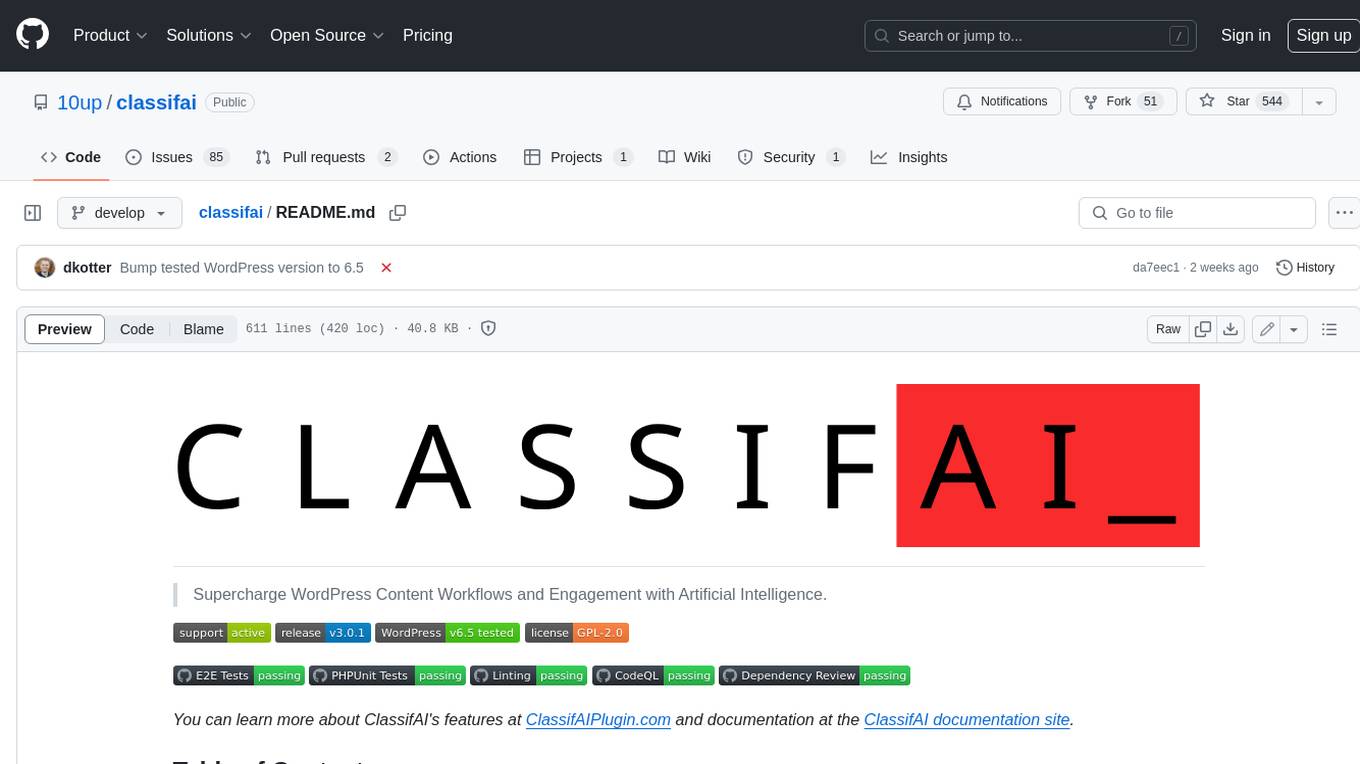
classifai
Supercharge WordPress Content Workflows and Engagement with Artificial Intelligence. Tap into leading cloud-based services like OpenAI, Microsoft Azure AI, Google Gemini and IBM Watson to augment your WordPress-powered websites. Publish content faster while improving SEO performance and increasing audience engagement. ClassifAI integrates Artificial Intelligence and Machine Learning technologies to lighten your workload and eliminate tedious tasks, giving you more time to create original content that matters.

chatbot-ui
Chatbot UI is an open-source AI chat app that allows users to create and deploy their own AI chatbots. It is easy to use and can be customized to fit any need. Chatbot UI is perfect for businesses, developers, and anyone who wants to create a chatbot.

BricksLLM
BricksLLM is a cloud native AI gateway written in Go. Currently, it provides native support for OpenAI, Anthropic, Azure OpenAI and vLLM. BricksLLM aims to provide enterprise level infrastructure that can power any LLM production use cases. Here are some use cases for BricksLLM: * Set LLM usage limits for users on different pricing tiers * Track LLM usage on a per user and per organization basis * Block or redact requests containing PIIs * Improve LLM reliability with failovers, retries and caching * Distribute API keys with rate limits and cost limits for internal development/production use cases * Distribute API keys with rate limits and cost limits for students

uAgents
uAgents is a Python library developed by Fetch.ai that allows for the creation of autonomous AI agents. These agents can perform various tasks on a schedule or take action on various events. uAgents are easy to create and manage, and they are connected to a fast-growing network of other uAgents. They are also secure, with cryptographically secured messages and wallets.

griptape
Griptape is a modular Python framework for building AI-powered applications that securely connect to your enterprise data and APIs. It offers developers the ability to maintain control and flexibility at every step. Griptape's core components include Structures (Agents, Pipelines, and Workflows), Tasks, Tools, Memory (Conversation Memory, Task Memory, and Meta Memory), Drivers (Prompt and Embedding Drivers, Vector Store Drivers, Image Generation Drivers, Image Query Drivers, SQL Drivers, Web Scraper Drivers, and Conversation Memory Drivers), Engines (Query Engines, Extraction Engines, Summary Engines, Image Generation Engines, and Image Query Engines), and additional components (Rulesets, Loaders, Artifacts, Chunkers, and Tokenizers). Griptape enables developers to create AI-powered applications with ease and efficiency.





